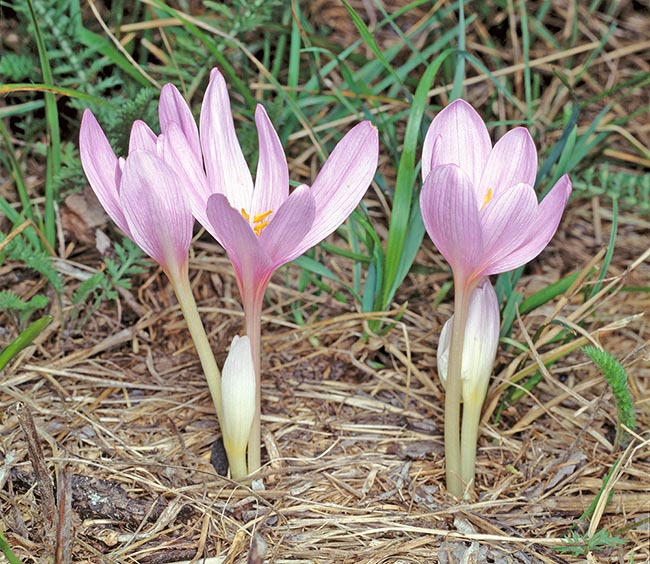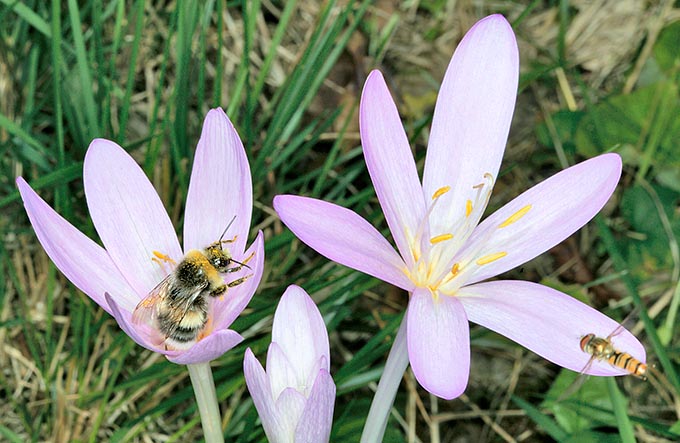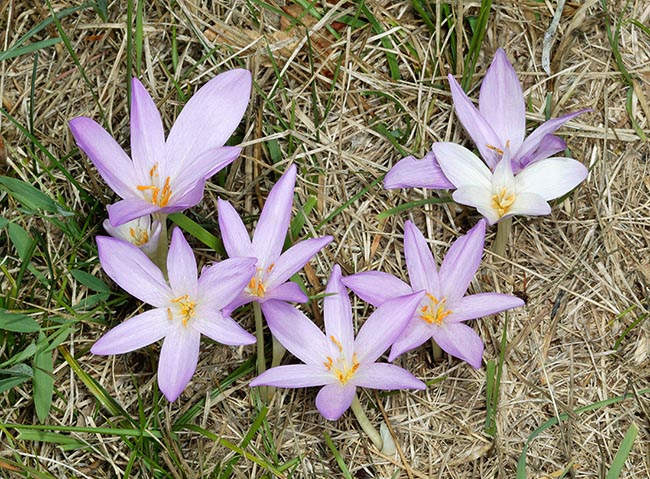Family : Colchicaceae

Text © Eugenio Zanotti

English translation by Mario Beltramini

Colchicum autumnale flowers bloom late summer, but the fruits develop in spring © Giuseppe Mazza
The name of the species “autumnale” is refers to the flowering period of this species.
The autumn crocus, known also as meadow saffron or naked lady (Colchicum autumnale L. 1753) is a (5) 10-40 cm tall, glabrous, perennial, herbaceous species, furnished of pyriform or ellipsoid bulb-tuber of 3 x 4 (7) cm, wrapped by a brownish or red-blackish cover, very deep into the ground. Four leaves (rarely 3-7), rooting, erect, little fleshy, entire, intense green on both faces, widely lanceolate (the outer one of 4-7 x 25-26 cm), 3-5 times longer than broad, acute at the apex.
One to three (7) flowers wrapped at the base by a hyaline, mucronate spathe, with thin membranous wings; perigonioum with colourless 10-25 (25) cm long tube and six pink or slightly lilac laciniae, the outer ones narrower; 6 stamina 3 of which with 15 mm filaments, the other 10 mm; yellow, 5 mm anthers, linear, dorsifixed; erect (20-25 mm) styles just widened in a 2-2,5 mm stigma, papillose and hook curved. The entomophilous pollination is done by flies and bees.
The fruit is a trilocular capsule of 2-2,7 x 3,4 – 5,5 cm, ovoid-elongated, acute at the apex, initially green then brown, containing several seeds, globose, very hard, red-brown to blackish, superficially knurled, and, when fresh, somewhat sticky due to a fleshy outgrowth that, with the humidity, gets gelatinous (this favours the zoophilic dissemination).

The pollination, entomophilous, is done by dipterans, bees and bumblebees © Giuseppe Mazza
The blooming of the autumn crocus happens from August to September, after which the flowers rapidly disappear and only in the next spring there will be the development of a short stem carrying the fruit wrapped by the leaves. And from that we get the impression that the fructification takes place one month before the flowering!
All the plant, but especially the seeds (collected in June and July) contain starch, albuminoid substances, sugars, tannin, gallic acid, phytosterine and one oil), and the bulbs-tubers (collected in August) containing besides the starch, inulin, gum, tannin, resins, and one fat oil, the alkaloid colchicine, odourless but with very bitter taste.
The colchicine acts essentially on the capillary circulation and has been employed as antiarthritic, antirheumatic, diuretic, but especially as specific remedy for the pain caused by the fits of acute gout (but ineffective in the chronic gout), excluding the patients with kidney and colitic problems. The colchicine inhibits the phagocytosis of the crystals of uric acids thus interrupting the vicious circle of the inflammatory process. Moreover, the colchicine acts inhibiting the cell mitosis and therefore favours the polyploidy, so the colchicine has a remarkable importance in the field of the experimental cytology and is used, for instance, to induce the hybridization between different vegetal species.

It gives the colchicine, good in the gout flares and as antiarthrititic, antirheumatic and diuretic © Giuseppe Mazza
The use is of exclusive medical pertinence due to the high toxicity (the mortal dosage for a man stands around the 20-60 mg). High therapeutic doses may cause nausea, vomit, diarrhoea, abdominal cramps, renal damages, burning sensations in the throat and on the skin. With greater doses, arise cardiovascular collapse, delirium, convulsions, prostration, ascending paralysis and, finally, death. The prolonged use causes agranulocytosis, aplastic anemia, neuritides, etc.
The autumn crocus has caused several poisonings, even fatal, due to the confusion with similar species with edible bulbs, especially belonging to the genus Crocus which, however, distinguish for the strictly linear leaves, some mm broad, present at the blooming and different floral characters, such as the funnel extended or flabellate stigma.
Synonyms: Colchicum commune Necker (1768); Colchicum autumnale L. var. vernum Reichard (1779); Colchicum vernale Hoffm. (1791); Colchicum multiflorum Brot. (1804); Colchicum polyanthon Ker Gawl. (1807); Colchicum autumnale L. var. neapolitanum Ten. (1825); Colchicum praecox Spenn. (1825); Colchicum patens F.W. Schultz (1826); Colchicum cupanii Guss. (1827); Colchicum autumnale L. var. viridiflorum Opiz (1852); Colchicum pannonicum Griseb. & Schenk (1852); Colchicum haynaldii Heuffel (1858); Colchicum transsilvanicum Schur (1866); Colchicum corsicum Baker (1879); Colchicum autumnale L. var. transsilvanicum (Schur) Nyman (1882); Colchicum autumnale L. var. vernale (Hoffm.) Nyman (1882); Colchicum autumnale L. subsp. pannonicum (Griseb. & Schenk) Nyman (1882); Colchicum autumnale L. var. speciosissimum Bubela (1884); Colchicum autumnale L. var. lucanum N.Terrac. (1873); Colchicum autumnale L. var. pannonicum (Griseb. & Schenk) Baker (1879); Colchicum autumnale L. subsp. vernum (Reichard) Nyman (1890); Colchicum autumnale L. var. castrovillarense N.Terrac. (1891); Colchicum autumnale L. var. tenorei (Parl.) Fiori (1894); Colchicum autumnale L. var. todaroi (Parl.) Fiori (1894); Colchicum autumnale L. subsp. algeriense Batt. (1895); Colchicum bulgaricum Velen. (1901); Colchicum autumnale L. var. algeriense (Batt.) Batt. & Trab. (1905); Colchicum autumnale L. var. elatius Simonk. (1906); Colchicum autumnale L. f. transsilvanicum (Schur) Domin (1909); Colchicum autumnale L. f. bulgaricum (Velen.) Domin (1909); Colchicum autumnale L. f. pannonicum (Griseb. & Schenk) Domin (1909); Colchicum autumnale L. proles vernale (Hoffm.) Rouy (1910); Colchicum autumnale L. var. fritillatum Samp. (1910); Colchicum autumnale L. var. bivonae (Guss.) Fiori (1923); Colchicum autumnale L. var. corsicum (Baker) Fiori (1923); Colchicum autumnale L. var. provinciale (H.Loret) Fiori (1923); Colchicum autumnale L. var. variopictum (Janka) Fiori (1923) Colchicum autumnale L. var. kochii (Parl.) Fiori (1923); Colchicum autumnale L. var. bulgaricum (Velen.) Stoj. & Stef. (1925); Colchicum autumnale L. var. gibraltaricum Kelaart (1946); Colchicum autumnale L. var. multiflorum (Brot.) Samp. (1947); Colchicum autumnale L. f. macropetala M.Gajic (1977); Colchicum autumnale L. f. milosi M.Gajic (1977); Colchicum autumnale L. f. radei M.Gajic (1977).
→ To appreciate the biodiversity within the COLCHICACEAE family please click here.
